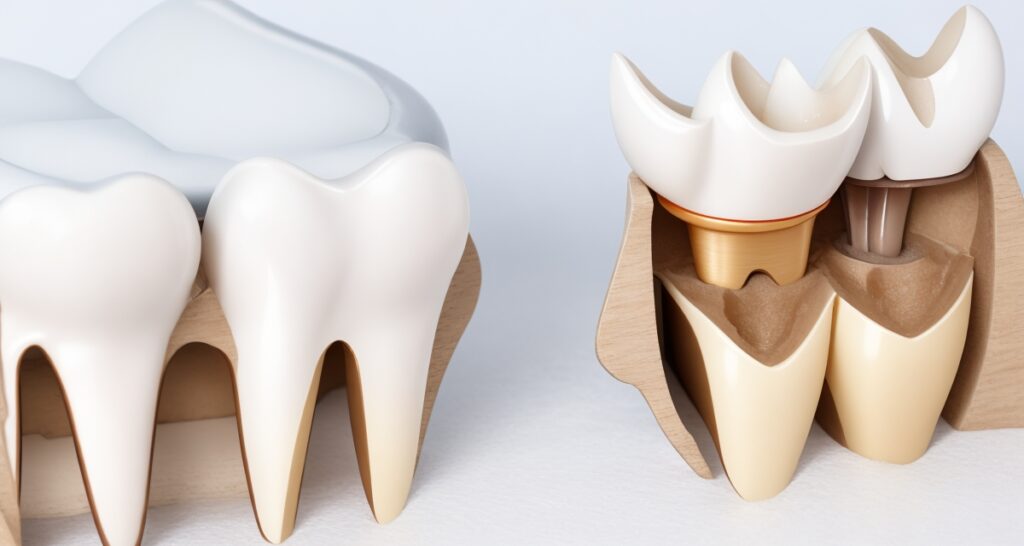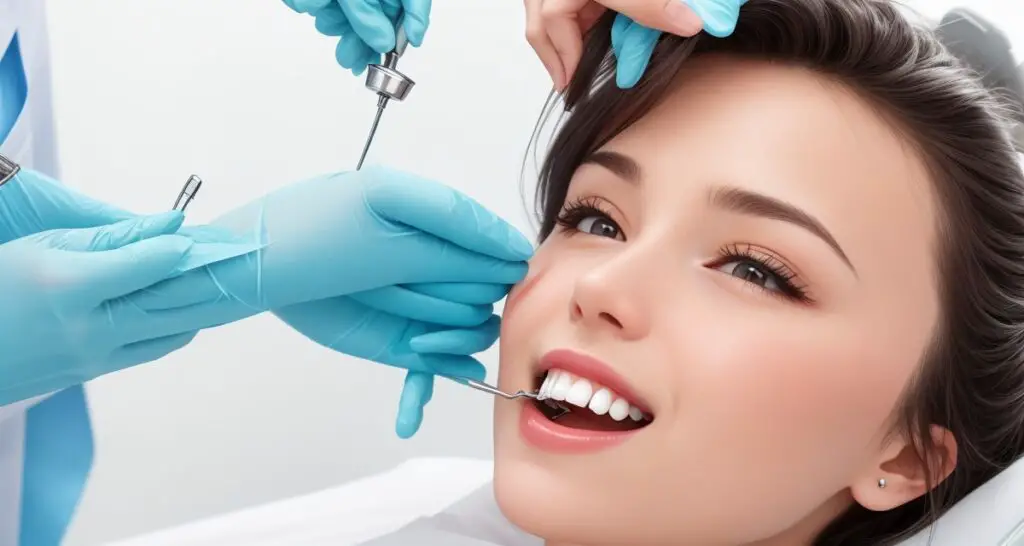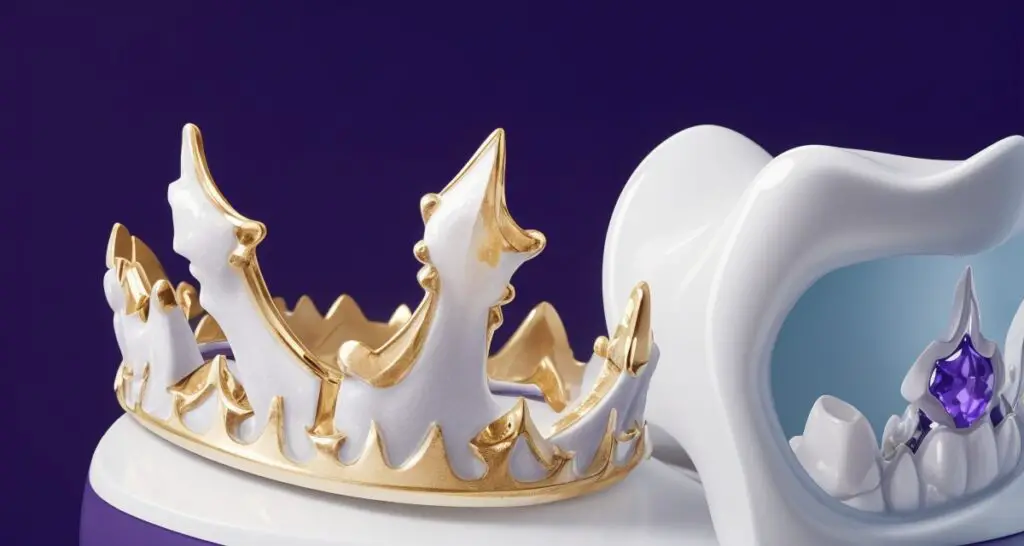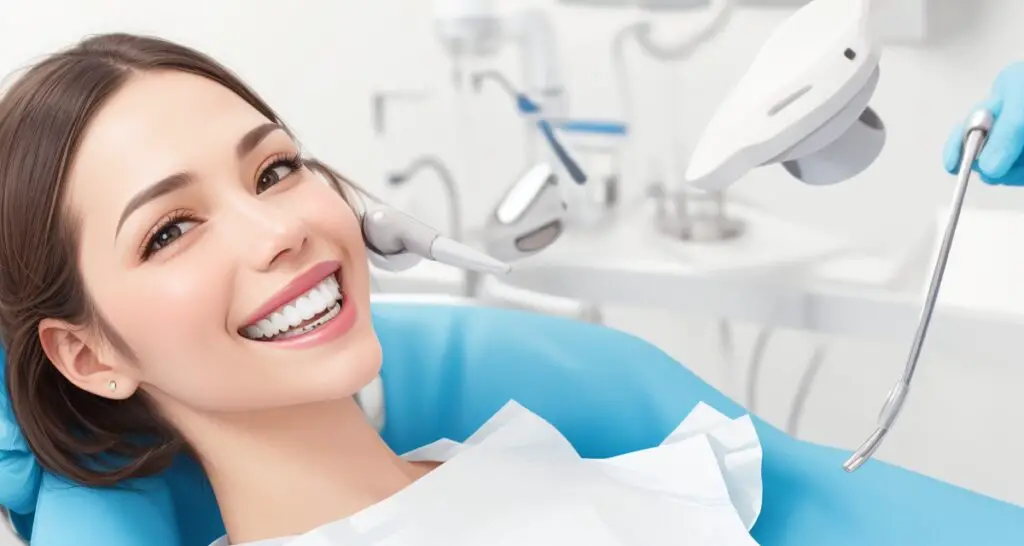If you’ve ever found yourself in need of a dental crown, you may have wondered, How much does it cost for a tooth crown? Dental crowns are a common dental procedure used to restore and protect damaged or weakened teeth. However, the cost of getting a tooth crown can vary significantly based on various factors, including the type of crown, your location, and your dental insurance coverage. In this guide, we will explore the key factors that influence the cost of a tooth crown, helping you make an informed decision about this important dental investment.
Understanding the Importance of Tooth Crowns
Tooth crowns, often referred to as dental crowns or caps, are a vital component of modern dentistry. They play a crucial role in restoring damaged or decayed teeth to their former glory. These custom-made, tooth-shaped covers are placed over a tooth, reinforcing its structure and enhancing its function. Tooth crowns serve a dual purpose: they protect and strengthen weakened teeth, while also improving their appearance. Whether you have a tooth with extensive damage due to decay, trauma, or wear and tear, a tooth crown can be the knight in shining armor for your smile.
Beyond their structural benefits, tooth crowns are designed to mimic the natural look of your teeth, ensuring that your smile remains beautiful and seamless. Whether it’s a molar, premolar, or front tooth, crowns are tailored to match the color, size, and shape of your natural teeth, making them virtually indistinguishable. This aesthetic aspect can boost your self-confidence, making you more willing to flaunt your smile without any hesitation.
Factors Affecting the Cost
The cost of a tooth crown is not a one-size-fits-all figure; it’s a dynamic calculation influenced by numerous factors. Understanding these variables is essential to grasp the financial aspects of this dental procedure.
1. Type of Crown Material:
Dental crowns come in various materials, including ceramic, porcelain-fused-to-metal, gold, and zirconia. Each material has its unique properties and price range, with ceramic crowns offering high aesthetics but often coming at a higher cost, while gold crowns may be less aesthetically pleasing but can be more affordable.
2. Dentist’s Experience and Location:
The expertise and geographical location of your chosen dentist can significantly impact the overall cost. Highly experienced dentists in urban areas may charge more for their services compared to those in rural locations.
3. Additional Procedures:
Sometimes, tooth preparation necessitates additional procedures, like root canals or gum recontouring, which can add to the total cost.
4. Dental Insurance:
The presence or absence of dental insurance also plays a critical role in cost determination. Some insurance plans cover a portion of the expenses, alleviating the financial burden for the patient.
Understanding these cost-affecting factors will empower you to make informed decisions when considering a tooth crown, ensuring that you receive quality dental care without breaking the bank.
Types of Tooth Crowns

Ceramic Crowns
1. Distinctive Features and Aesthetics
Ceramic crowns are celebrated for their remarkable ability to closely emulate the natural appearance of teeth. Skillfully crafted from porcelain, they possess a captivating translucence and luster that is practically indistinguishable from genuine enamel. These crowns, favored for front teeth, enchant with their aesthetic advantages, creating a harmonious blend with your natural teeth, thereby ensuring a smile of captivating elegance.
2. Price Range
While ceramic crowns are cherished for their lifelike aesthetics, this remarkable realism often comes at a somewhat higher investment. The cost of ceramic crowns typically spans from $800 to $3,000 per crown. This cost variation is influenced by factors such as the geographical location of the dental clinic, the practitioner’s expertise, and the intricacy of the restoration. Patients willingly invest a bit more for the exceptional beauty they bestow.
Porcelain-Fused-to-Metal Crowns
1. Robustness and Aesthetics
Porcelain-fused-to-metal (PFM) crowns artfully amalgamate the robustness of metal with the natural allure of porcelain. The metal substructure offers unwavering support, rendering PFM crowns an exceptional choice for molars and premolars. The porcelain exterior guarantees a realistic appearance, with an aesthetic outcome that is highly commendable, though not quite reaching the seamless perfection of ceramic crowns.
2. Price Comparison
PFM crowns generally fall within a more moderate price range, ranging from $500 to $1,500 per crown. Their cost-effectiveness is particularly attractive to discerning patients who seek a harmonious balance between aesthetics and durability. The total expense is contingent on factors such as the selection of the dental clinic, the specific materials employed, and the geographic location of the practice.
Gold Crowns
1. Unique Characteristics
Gold crowns may not be celebrated primarily for their aesthetics, but they offer distinctive advantages in terms of strength and longevity. Their impressive durability designates them as an excellent choice for teeth subjected to significant biting and chewing forces. Moreover, the biocompatibility of gold reduces the likelihood of allergic reactions or adverse responses from the surrounding tissues.
2. Cost Considerations
While gold crowns undeniably excel in durability, their cost considerations may not be as immediately alluring. Prices for gold crowns typically span from $600 to $2,500 per crown. The cost variation is contingent on factors such as the quantity of gold employed, the dental clinic’s pricing structure, and your geographical location. Patients who opt for gold crowns generally do so for the assurance of remarkable longevity, making it a prudent investment.
Zirconia Crowns
1. Strength and Aesthetic Excellence
Zirconia crowns represent a contemporary innovation known for their robustness and endurance. Fashioned from zirconium oxide, these crowns exhibit exceptional resilience, rendering them suitable for both front and rear teeth. Their aesthetics are equally striking, presenting a natural appearance devoid of any visible metal, further contributing to their attractiveness.
2. Pricing Spectrum
The price range for zirconia crowns typically falls between $800 and $2,500 per crown. The overall cost is influenced by factors such as the intricacy of the restoration, the location of the dental clinic, and the specific materials selected. Zirconia crowns deftly strike a balance between strength and aesthetics, making them a favored choice among patients seeking enduring, naturally captivating dental restorations.
The Dental Crown Procedure

Consultation and Examination
Prior to embarking on your dental crown journey, a comprehensive consultation and examination with your dentist are imperative. During this preliminary phase, your dentist will evaluate the condition of your tooth, discuss your concerns, and consider your oral health history. This step allows for a customized treatment plan tailored to your specific needs, ensuring that the crown will be the ideal solution for your dental issue.
Tooth Preparation
The tooth preparation stage is a pivotal part of the dental crown procedure, encompassing two significant sub-stages:
1. Local Anesthesia
To ensure your comfort throughout the process, your dentist will administer local anesthesia to numb the tooth and its surrounding area. This ensures that you experience minimal to no discomfort during the subsequent steps.
2. Shaping the Tooth
Shaping the tooth involves precise and artful tooth reduction to create the necessary space
for the crown to fit snugly. This involves gentle removal of the outer layer of the tooth, often damaged or decayed, allowing the crown to be seamlessly affixed. The shaping process is crucial to achieving a secure and well-fitting crown.
Impressions and Temporary Crown
Once the tooth is appropriately shaped, impressions of your prepared tooth and neighboring teeth are taken. These impressions are used as a blueprint for crafting your custom crown. While your permanent crown is being fabricated in a dental laboratory, a temporary crown is securely placed over your prepared tooth to protect it and maintain your smile’s appearance.
Crown Fabrication
Your dental impressions are sent to a skilled dental laboratory where your permanent crown is meticulously crafted. The chosen crown material, whether ceramic, porcelain-fused-to-metal, gold, or zirconia, is shaped, colored, and polished to perfection. The result is a crown that not only fits precisely but also mirrors the natural aesthetics of your teeth.
Crown Placement
The final and eagerly awaited step is the placement of your custom dental crown. Once your permanent crown is ready, your dentist will carefully remove the temporary crown, ensuring that the prepared tooth is clean and ready to receive the new crown. The permanent crown is then affixed in place using specialized dental cement, ensuring a snug and enduring fit. Any necessary adjustments are made to guarantee your bite is comfortable and your smile is beautifully restored.
This meticulous process ensures that your dental crown serves both functional and aesthetic purposes, enhancing your oral health and overall appearance.
Dental Crown Cost Breakdown

Dentist’s Fees
1. Location and Experience
The fees charged by your dentist play a significant role in the overall cost of a dental crown. The location of the dental practice, whether in an urban area or a rural setting, can affect pricing. Furthermore, the experience and reputation of the dentist will also influence the cost. Highly experienced and well-known dentists may charge more for their expertise in performing crown procedures, while those in less populous areas may offer more competitive pricing.
Material Costs
1. Type of Crown
The material you select for your dental crown is a crucial determinant of the overall cost. The various types of crowns, such as ceramic, porcelain-fused-to-metal, gold, and zirconia, come with differing price tags. Ceramic and porcelain-fused-to-metal crowns often fall within the mid-range of pricing, while gold crowns are known to be costlier due to the use of precious metals. Zirconia crowns, combining strength and aesthetics, also have a specific pricing structure. Your choice should align with your budget and aesthetic preferences.
2. Lab Fees
To the crown material cost, there are laboratory fees associated with crafting the custom crown. These fees cover the skilled labor and materials required to create your personalized crown. Depending on the complexity and precision of your crown design, these lab fees can vary. High-quality dental laboratories may charge more for their craftsmanship, ultimately impacting the overall cost of the crown.
Additional Procedures
1. Root Canal
In some cases, the need for a root canal procedure prior to crown placement can influence the total cost. A root canal is necessary when the tooth’s pulp is infected or damaged. This procedure involves removing the infected tissue and filling the tooth’s interior, ensuring it is infection-free before the crown is placed. The cost of a root canal, if required, adds to the overall dental crown expense.
2. Gum Recontouring
Gum recontouring, also known as gingival contouring, may be needed to ensure a seamless fit for your dental crown. If your gums are uneven or need reshaping to accommodate the crown properly, this Procedure can impact costs. The complexity and extent of the gum recontouring required will influence the final expense.
Understanding the detailed breakdown of dental crown costs allows you to make informed decisions regarding your oral health and budget. It is essential to discuss these cost factors with your dentist to ensure you receive the best crown option for your specific needs.
Insurance Coverage

Dental Insurance
Dental insurance serves as a vital financial safeguard, contributing significantly to the accessibility of dental crown procedures. It acts as a protective buffer for your wallet, making sure your oral health needs don’t become a financial burden. Here’s a deeper look at its intricacies:
Dental insurance coverage often comes with specific limits, either on an annual or lifetime basis. These limits determine how much of the cost associated with dental crown procedures your insurance plan will cover. Understanding these limits is crucial, as it will impact your out-of-pocket expenses.
One essential aspect to consider is the issue of pre-existing conditions. Some dental insurance plans might not cover dental problems that were already present before you obtained the insurance. Thus, it’s prudent to carefully review your plan’s terms to see if your dental crown qualifies for coverage.
Dental insurance often distinguishes between in-network and out-of-network providers. In-network dentists are preferred by the insurance company and, as a result, provide more extensive coverage and reduced out-of-pocket expenses. Therefore, selecting an in-network dentist can help you maximize your insurance benefits.
Alternative Financing Options
1. CareCredit
CareCredit is a flexible financial solution, akin to a healthcare credit card, tailor-made to meet the financial needs of individuals seeking medical and dental procedures. It presents a compelling array of advantages designed to put control and flexibility back into your hands.
With CareCredit, you can craft personalized payment plans that transform the cost of your dental crown procedure into manageable monthly installments. This enables you to comfortably fit this essential procedure into your budget without undue financial strain.
Interest-free periods, available depending on the CareCredit plan you choose, offer you the advantage of financing your dental crown without incurring Interest costs for a specified duration. This financial breathing space can be immensely valuable in your healthcare journey.
Perhaps one of the most attractive features of CareCredit is its broad acceptance within the healthcare community, including dental practices. This means you can utilize your CareCredit account for various dental procedures, granting you the flexibility to prioritize your oral health without financial stress.
2. Payment Plans
Dental practices frequently offer their in-house payment plans, extending a helping hand to individuals looking for a way to distribute the cost of their dental crown procedure over a span of several months. These payment plans offer a host of benefits, including:
Customization is at the heart of these plans. They are typically tailored to align with your specific financial situation and budget constraints. Your dentist works with you to create a payment schedule that ensures that your oral health remains a top priority while accommodating your unique financial needs.
Payment plans often do not require credit checks. This characteristic extends accessibility to a more comprehensive range of patients, irrespective of their credit history, ensuring that oral health remains inclusive and accessible.
When considering payment plans, it’s essential to inquire about interest rates. While some plans may not include interest charges, it’s crucial to clarify these terms to understand the complete financial picture. Understanding the terms ensures that you can make informed decisions regarding your oral health without any financial surprises.
Geographic Variations in Costs

Regional Disparities
The realm of dental crown costs is marked by intriguing regional disparities, which have a profound impact on the financial aspect of your dental journey. These disparities are influenced by a multitude of factors, each deserving a closer look:
1. Cost of Living:
Regions with a higher cost of living, notably major metropolitan areas, often witness an upswing in dental expenses. The elevated operational costs faced by dental practices in these locations, encompassing rent, utilities, and staff salaries, naturally reflect in the pricing of dental crown procedures.
2. Competition:
The level of competition among dental practices in a particular region exerts a compelling influence on pricing dynamics. In areas swarming with dental offices, the competitive landscape may prompt dentists to fine-tune their pricing strategies to attract and retain patients, potentially leading to more attractive costs.
3. Supply and Demand:
The demand for dental services is a quintessential driver of pricing variations. In regions where the demand for dental crowns is high, prices might escalate in response to increased patient interest.
4. Access to Materials:
The availability and cost of dental materials can significantly vary by region. The costs associated with acquiring these materials can ripple through the pricing structure, ultimately impacting the total expense of dental crown procedures.
Urban vs. Rural Prices
The distinction in dental crown costs between urban and rural settings is a captivating facet that demands exploration:
1. Urban Prices:
Dental services in urban settings are often priced at a premium due to higher overhead costs, predominantly driven by the elevated cost of living in cities. Dentists in urban areas may consequently charge slightly higher rates to offset these operational expenses.
2. Rural Prices:
Dental practices situated in rural areas typically bear lower operational costs. This favorable cost structure translates into more affordable dental crown prices in rural regions, rendering them a compelling option for patients who prioritize cost-effectiveness.
Understanding these geographic disparities in dental crown costs empowers individuals to make informed choices that align with their financial circumstances and preferences. Whether it involves seeking cost-effective care in rural regions or the convenience of urban dental practices, the geographic element plays a pivotal role in crafting a personalized approach to dental health.
Factors Influencing Crown Costs
Tooth Location
The location of the tooth that requires a crown is a fundamental determinant of the overall cost of the procedure. Dental crowns are utilized for teeth at various positions in the mouth, each with its unique considerations:
1. Front Teeth:
Crowns for front teeth, often visible when you smile, demand meticulous craftsmanship to ensure a natural appearance. Consequently, the cost may be higher due to the emphasis on aesthetics.
2. Molars and Premolars:
Crowns for molars and premolars, positioned in the back of the mouth and primarily responsible for chewing, necessitate durability. While aesthetics still matter, the emphasis shifts towards functionality. This might affect the choice of materials and, in turn, the overall cost.
Severity of Damage
The extent of damage or dental issues affecting the tooth plays a pivotal role in determining crown costs. Different scenarios influence pricing:
1. Minor Damage:
Crowns for minor damage, such as small cavities or minimal wear, are generally less expensive. These cases often require less tooth reduction and straightforward restoration.
2. Extensive Damage:
Teeth with significant damage, extensive decay, or structural issues may necessitate more intricate crown procedures, possibly involving Treatments like root canals. The complexity of these cases can drive up costs.
Dentist’s Reputation
The reputation and expertise of the dentist performing the crown procedure have a direct impact on costs. Dentists with a well-established reputation for exceptional skill and precision may charge higher fees. While these costs may be elevated, they often reflect the assurance of high-quality results and patient satisfaction.
Materials Used
The choice of materials for the dental crown significantly influences the overall cost. Each material option comes with distinct characteristics and price points:
1. Ceramic and Porcelain:
These materials are prized for their natural aesthetics but are typically more costly due to their lifelike appearance.
2. Gold:
Gold crowns, valued for their durability, may also come at a premium price, driven by the cost of precious metal.
3. Zirconia:
Zirconia crowns strike a balance between strength and aesthetics, offering competitive pricing.
These factors interact in a multifaceted manner to shape the cost of your dental crown procedure, ensuring a personalized approach that caters to your unique oral health needs and financial considerations.
Case Studies
Sample Cases and Associated Costs
In the realm of dental crown procedures, examining real-life case studies provides invaluable insights into the varied scenarios and the associated costs. Delving into these sample cases allows us to appreciate the diverse factors that influence the financial aspect of dental crown treatments.
Case 1: Aesthetic Excellence
In this case, a patient seeks a dental crown for a highly visible front tooth. The paramount concern is the seamless integration of the crown with the natural teeth, emphasizing aesthetics. As a result, a ceramic crown is recommended due to its ability to replicate the appearance of real teeth. The meticulous craftsmanship required for such cases often translates into a higher cost, ranging from $1,000 to $3,000.
Case 2: Functional Restoration
For another patient, the need for a crown arises due to extensive damage to a molar, affecting their ability to chew comfortably. In cases like this, the emphasis is on durability and functionality. A porcelain-fused-to-metal (PFM) crown is a suitable choice, offering a balance between strength and aesthetics. The cost may vary from $800 to $1,500, depending on the complexity of the restoration required.
Case 3: Unique Material Selection
In this intriguing case, a patient opts for a gold crown for a molar, prioritizing durability. Gold crowns are celebrated for their exceptional longevity, making them a favorable choice for teeth subjected to substantial biting and chewing forces. The cost in such instances may range from $600 to $2,500, reflecting the use of precious metal.
Case 4: Strength and Aesthetics Combined
A patient seeks a dental crown for a tooth that demands both strength and aesthetics. Zirconia crowns come into play, offering the perfect blend of durability and a natural appearance with no visible metal. The cost, in this case, typically falls between $800 and $2,500, taking into account factors such as the complexity of the restoration and the specific materials used.
These sample cases vividly illustrate the diversity of patient needs, each calling for a tailored approach in terms of materials, craftsmanship, and cost. By exploring such cases, patients gain a deeper understanding of how dental crown costs are intricately linked to individual requirements, ultimately guiding them toward informed decisions on their oral health journey.
Cost vs. Longevity
How Much Does It Cost For A Tooth Crown?
Balancing Quality and Expense
When it comes to dental crown procedures, finding the delicate equilibrium between cost and longevity is paramount for patients. The choices made in this realm hold significant implications for oral health and financial well-being.
1. Quality Matters:
Dental crowns are not one-size-fits-all solutions. They are tailored to address specific dental issues, ranging from aesthetics to functionality. The choice of crown material, such as ceramic, porcelain-fused-to-metal, gold, or zirconia, profoundly influences both the quality and cost. Quality is often reflected in the aesthetics, durability, and overall performance of the crown.
2. Longevity:
Dental crowns are long-term investments in oral health. Their lifespan can range from 5 to 15 years or more, depending on various factors. The longevity of a crown is not solely determined by its cost but also by the materials used, the precision of the dental procedure, and individual oral hygiene practices.
3. Balancing Act:
Balancing cost and longevity is a nuanced process. Opting for the least expensive crown may lead to earlier replacements, ultimately increasing the long-term expense. Conversely, choosing the most expensive option may provide unparalleled quality but could be cost-prohibitive for some.
4. Consultation is Key:
To strike the right balance, consulting with a dentist is imperative. A dental professional can assess your unique dental needs, budget, and oral health goals to recommend the most suitable crown option. This personalized guidance ensures that you receive the best value for your investment.
Selecting the Ideal Dentist
Research and Reviews
Choosing the perfect dentist for your dental crown procedure is an essential stride toward ensuring a gratifying and prosperous journey. Here’s a guide to make the process graceful and efficient:
1. Explore Your Options:
Initiate your quest by crafting a roster of potential dentists within your vicinity who extend dental crown services. Unearth them through digital search engines, peruse dental directories, or kindly seek counsel from your close-knit circle of friends and family.
2. Validate Qualifications:
Scrutinize the dentist’s credentials with diligence, encompassing their educational background, certifications, and any specialized training in the realm of restorative dentistry or prosthodontics. Assurance of their licensure and positive standing within the pertinent dental associations is paramount.
3. Peruse Patient Praise:
Traverse the terrain of online reviews and heartening testimonials bestowed by antecedent patients. These archives offer priceless glimpses into the dentist’s adeptness, their capacity to create a soothing chairside ambiance, and the holistic patient experience. Be vigilant for recurring endorsements and pay heed to recurrent concerns.
4. Probe Their Proficiency:
Embark on a conversation about the dentist’s experience pertaining to dental crown procedures. A dentist entrenched in experience is more inclined to furnish you with efficacious treatment and is adept at navigating any unforeseen complexities that may transpire during the journey.
5. Embrace Technological Proficiency:
Encourage a discourse regarding the dental technology and techniques harnessed by the dentist. Contemporary equipment and leading-edge techniques hold the potential to amplify the caliber of your treatment and elevate the holistic experience.
Artful Consultation
The consultation session with your forthcoming dentist represents a pivotal juncture in sculpting an enlightened choice. These are the guidances to optimize the consultation experience:
1. Cultivate Queries:
In the lead-up to your consultation, cultivate a compendium of questions or qualms germinating within your consciousness about the dental crown procedure. This premeditation ensures that you glean every iota of information requisite for informed decision-making.
2. Dialogue on Treatment Alternatives:
Amid the consultation, the dentist should illuminate a diverse array of treatment alternatives. These may encompass the selection of crown materials, cost approximations, and a meticulous dissection of the procedural timeline. The cogitation of your predilections and financial constraints is imperative.
3. Scrutinize Communication Prowess:
Partake in an assessment of the dentist’s efficacy in communicating with you. A superlative dentist is one who listens intently to your concerns, proffers lucid explanations of the treatment alternatives, and conscientiously addresses any questions or reservations within the chambers of your cognizance.
4. Examine Payment Channels:
Extend inquiries anent the plenitude of payment channels and the dentist’s willingness to accommodate your dental insurance or proffer alternative financial resources such as amiable payment plans or the assistance of CareCredit.
5. Invest in Your Intuition:
In summation, the bedrock of this journey lies in your trust in your intuition during the consultation. Elect a dentist with whom you resonate in a harmonious cadence, one who envelops you in an aura of assurance and confidence. The embrace of a positive relationship between patient and dentist is the cornerstone of a triumphant odyssey toward a vigorous and self-assured smile.
Considerations for Special Situations
Pediatric Dental Crowns
When it comes to dental crowns for children, several unique considerations are vital to ensuring their dental well-being. Let’s explore these special aspects with care and thoroughness:
1. Pediatric Dentists:
It’s highly advisable to consult pediatric dentists who specialize in the delicate care of young patients. These compassionate professionals possess the knowledge and skills necessary to address the specific needs of children, especially when dental crowns are involved.
2. Assessing Necessity:
The decision to recommend a dental crown for a child is often associated with significant dental concerns, such as extensive tooth decay, trauma, or developmental issues. An experienced dentist conducts a comprehensive assessment to determine the necessity of this treatment, considering the child’s unique situation.
3. Material Selection:
Dental crowns for children are thoughtfully selected from materials like stainless steel or tooth-colored options. Stainless steel crowns, known for their durability, are often chosen for posterior teeth, while tooth-colored crowns are preferred for anterior teeth to ensure a natural and aesthetically pleasing appearance.
4. Gentle Approach:
Pediatric dentists excel in creating a reassuring and positive environment for children during dental procedures. Their techniques are designed to minimize anxiety and ensure a pleasant experience for young patients, promoting trust and comfort.
5. Long-Term Oral Health:
Dental crowns for children are not a mere short-term solution; they play a crucial role in maintaining the health of primary (baby) teeth. These primary teeth are fundamental for proper development and alignment of permanent teeth, emphasizing the long-lasting importance of this treatment.
Emergency Crown Replacement
Addressing the need for an emergency crown replacement requires prompt and informed action. Let’s navigate the intricacies of this critical scenario with care and attention:
1. Causes of Emergencies:
Emergency crown replacements may become necessary due to various reasons, including a loose or lost crown, chipping, cracking, or underlying issues like decay or damage to the tooth beneath the crown.
2. Immediate Response:
In such situations, it is essential to promptly contact your dentist. They can offer guidance on whether the situation requires immediate attention or can be managed during a scheduled appointment, ensuring the patient’s comfort and well-being.
3. Temporary Solutions:
Depending on the circumstances, your dentist might suggest temporary remedies, such as dental cement or adhesive, to reattach a loose crown. It is crucial to follow their recommendations diligently to ensure the temporary fix holds.
4. Safeguarding the Crown:
If the crown is intact and has become loose, rinse it with water and store it securely. Your dentist may be able to reattach it, potentially saving you the cost and time associated with a complete replacement, with a focus on the patient’s convenience and peace of mind.
5. Addressing Root Issues:
It is vital to address any underlying dental problems that might have triggered the emergency, such as decay or damage to the tooth beneath the crown. This ensures the long-term success of the replacement crown, prioritizing the patient’s oral health and well-being.
Aftercare and Maintenance
Oral Hygiene
Maintaining proper oral hygiene is paramount after getting a dental crown. Here’s a comprehensive exploration of this essential aspect:
1. Brushing and Flossing:
Continue to brush your teeth at least twice a day and floss daily. Use a soft-bristle toothbrush and non-abrasive toothpaste to prevent damage to the crown and surrounding teeth. Floss gently to avoid dislodging the crown.
2. Crown Care:
Pay extra attention when brushing and flossing around the crown. Ensure that you clean the area where the crown meets your natural tooth, as plaque and bacteria can accumulate there. A floss threader or interdental brush can be helpful.
3. Mouthwash and Fluoride:
Consider using an antimicrobial mouthwash to reduce the risk of gum disease and decay. Fluoride toothpaste or rinses can help strengthen your teeth and prevent cavities.
4. Avoid Hard Foods:
Steer clear of hard or sticky foods that can potentially damage your crown. Chewing ice, biting on pens, or eating extremely sticky candies should be avoided to prolong the life of your crown.
5. Night Guards:
If you have a habit of grinding your teeth at night, consult your dentist about a night guard. This device can protect your crown from undue wear and tear.
Regular Check-ups
Scheduling and attending regular check-ups with your dentist are vital to ensure the longevity and effectiveness of your dental crown:
1. Frequency:
Plan for check-ups every six months or as recommended by your dentist. These appointments allow your dentist to assess the condition of your crown and address any emerging issues promptly.
2. Professional Cleaning:
During these visits, your dentist or dental hygienist will provide professional cleaning to remove plaque and tartar, preventing gum disease and decay around the crown.
3. Crown Inspection:
Your dentist will carefully examine the crown for any signs of wear, damage, or a loose fit. Early detection of problems can often prevent more significant issues.
4. X-rays:
Periodic X-rays may be necessary to evaluate the condition of the tooth beneath the crown and the integrity of the crown itself.
5. Expert Guidance:
These appointments are an opportunity to seek guidance from your dentist on any concerns or changes in your oral health. Your dentist can recommend adjustments or Care based on your specific needs.
In summary, aftercare and maintenance of your dental crown are essential for preserving its longevity and ensuring your overall oral health. Diligent oral hygiene practices and regular check-ups will help you enjoy a beautiful and healthy smile for years to come.
Conclusion
The cost of a tooth crown can vary significantly depending on several factors, including the type of crown, the materials used, the dentist’s fees, and geographic location. It’s essential to consult with your dentist to determine the most suitable option for your specific needs and budget. While the cost may be a consideration, investing in a tooth crown is an investment in your oral health and the long-term function and aesthetics of your teeth.
The cost of a tooth crown is a worthwhile expense to protect and enhance your dental health, ensuring that you can continue to smile with confidence and enjoy a functional, pain-free bite. Make an informed decision, and don’t hesitate to explore insurance coverage or financing options to make this essential dental procedure accessible to you.
FAQs
What is a dental crown, and why might I need one?
A dental crown typically costs between $1,000 and $3,000, depending on various factors like the type of crown, your location, and the dentist’s experience.
What are the different types of dental crowns, and how do their costs vary?
Ceramic crowns are known for their aesthetic appeal and typically cost between $800 and $3,000 per crown. Porcelain-fused-to-metal crowns are durable and more affordable, ranging from $500 to $1,500. Gold crowns are strong but less popular for aesthetics, with prices ranging from $600 to $2,500. Zirconia crowns offer a balance of strength and aesthetics, costing between $800 and $2,500 per crown.
Does dental insurance cover the cost of a dental crown?
Dental insurance may cover around 50% of the cost, but it’s crucial to check your policy’s details and consult with your insurance provider to understand your coverage.
Are there alternative financing options to help with the cost of a dental crown
CareCredit is a healthcare credit card that allows you to spread the cost over time with flexible payment plans. Many dental practices also offer their payment plans, allowing you to pay in installments.
Are there geographic variations in the cost of dental crowns?
Yes, there are geographic variations. Crowns tend to be more expensive in urban areas and less costly in rural regions.

